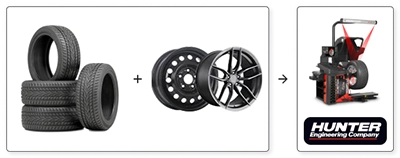How to read tire specifications?

How to Interpret Tire Specifications
This section on tires will help you deepen your knowledge for a better general understanding of their characteristics. These technical details will serve as a reference when purchasing your tires and will answer most of your questions. You’ll find additional content on load indices, the ideal time to change or buy your tires, how to read markings on the tire sidewall, and a guide on tire grip.
The first number represents the width of the tire, expressed in millimeters (mm). The second number is the aspect ratio (in %), which is the ratio between the height of the tire’s sidewall and its width. The number following the "R" refers to the inner diameter of the tire in inches and determines the wheel size on which the tire should be mounted.
A tire is defined by several criteria presented in the form of numbers and letters. This may seem a bit abstract, but in reality, it’s quite simple! To clarify this, let’s take an example with the size 235/45R18.
| Tire Specification | Description |
| 235 | Width |
| 45 | Aspect ratio in % |
| R | Radial construction |
| 18 | Wheel diameter in inches |
How to Choose the Right Tire Size for Your Vehicle
Choosing the correct tire size is essential to ensure the safety and performance of your vehicle. The tire size is indicated on the vehicle's label (such as the one located on the driver’s door frame) and in the owner’s manual. These references provide you with the exact tire size recommended by the manufacturer for your vehicle.

The dimensions of a tire are indicated by a series of numbers and letters, for example, 235/45R18. Here’s how to interpret each element:
- Width (235): This first number represents the width of the tire in millimeters, measured from one sidewall to the other.
- Aspect Ratio (45): This number is the ratio of the tire’s sidewall height to its width, expressed as a percentage.
- Construction (R): The letter "R" indicates that the tire is of radial construction, which is the case for most tires today.
- Diameter (18): This number indicates the wheel diameter in inches on which the tire should be mounted.
Make sure to always choose a tire size that respects these dimensions or those authorized by the car manufacturer. Using an incorrect size can affect handling, driving comfort, speedometer accuracy, and may even cause premature wear of tires or suspension components.
Speed Rating, Load Capacity, Ply Rating, and UTQG Rating
To guide you, we provide information on the origins and purpose of the speed rating marked on your tire’s sidewall. You’ll also find a reference table for the maximum rolling speed of your tires, along with several warnings about speed ratings when purchasing new tires. We’ve made available a chart for the load capacity of your vehicle and a list covering tire ply rating codes. To understand the three criteria considered in the Uniform Tire Quality Grading (UTQG), consult this section.
The Best Time to Change and Buy Your Tires
Wondering when is the best time to change your tires? We provide advice on this topic to maximize driving safety and reduce the risk of tire damage. Additionally, we specify the ideal time to buy new summer/all-season and winter tires. We also inform you about the importance and requirement of equipping your vehicle with winter tires.
Tire Age and the DOT – How to Read a Tire
We inform you about key elements concerning tire age and lifespan, based on the purchase date, manufacturing date, and external conditions that influence tire age. Discover where to find the manufacturing date (the DOT) on your tires. Finally, to better understand the markings on the sidewall, check out our custom guide with definitions of all important elements that may be inscribed on the tire.
Maximum Inflation Pressure
This is an important point to note. If a tire has a maximum inflation pressure (Max PSI) of 45 pounds, this doesn’t mean you should inflate it to this pressure. It’s simply the maximum pressure that the tire can withstand. When inflating your tires, refer only to the numbers in your owner’s manual, which have been carefully calculated by the vehicle’s engineers.
Before purchasing new tires, it’s essential to know how to read this information. If you have any questions, don’t hesitate to contact our customer service specialists, who will be happy to assist you.
Dominic Vaillancourt
Automotive expert & Spokesperson


